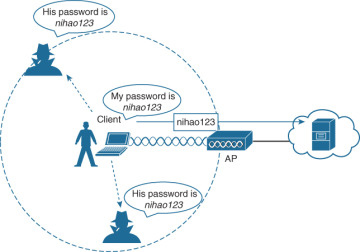Wireless traffic is inherently different from traffic traveling over a wired infrastructure. Any wireless device operating in the same frequency can hear the frames and potentially read them. Therefore, WLANs need to be secured to allow only authorized users and devices and to prevent eavesdropping and tampering of wireless traffic.
Wireless Authentication Methods
For wireless devices to communicate over a network, they must first associate with the AP. An important part of the 802.11 process is discovering a WLAN and subsequently connecting to it. During this process, transmitted frames can reach any device within range. If the wireless connection is not secured, then others can read the traffic, as shown.

The best way to secure a wireless network is to use authentication and encryption systems.
1. Open system authentication: Should only be used in situations where security is of no concern. The wireless client is responsible for providing security such as by using a virtual private network (VPN) to connect securely.
2. Shared key authentication: Provides mechanisms shown in Table 22-3 to authenticate and encrypt data between a wireless client and an AP. However, the password must be pre-shared between the parties to allow connection.
| Authentication Method | Description |
|---|---|
| Wired Equivalent Privacy (WEP) | The original 802.11 specification designed to secure the data using the Rivest Cipher 4 (RC4) encryption method with a static key. However, the key never changes when exchanging packets. This makes WEP easy to hack. WEP is no longer recommended and should never be used. |
| Wi-Fi Protected Access (WPA) | A Wi-Fi Alliance standard that uses WEP but secures the data with the much stronger Temporal Key Integrity Protocol (TKIP) encryption algorithm. TKIP changes the key for each packet, making it much more difficult to hack. |
| WPA2 | The current industry standard for securing wireless networks. It uses the Advanced Encryption Standard (AES) for encryption. AES is currently considered the strongest encryption protocol. |
| WPA3 | The next generation of Wi-Fi security. All WPA3-enabled devices use the latest security methods, disallow outdated legacy protocols, and require the use of Protected Management Frames (PMF). However, devices with WPA3 are not yet readily available. |
WPA and WPA2
Home routers typically have two choices for authentication: WPA and WPA2. WPA2 is the stronger of the two. WPA2 authentication methods included the following:
Personal: Intended for home or small office networks, users authenticate using a pre-shared key (PSK). Wireless clients authenticate with the wireless router using a pre-shared password. No special authentication server is required.
Enterprise: Intended for enterprise networks but requires a Remote Authentication Dial-In User Service (RADIUS) authentication server. Although more complicated to set up, it provides additional security. The device must be authenticated by the RADIUS server, and then users must authenticate using the 802.1X standard, which uses Extensible Authentication Protocol (EAP) for authentication.
802.1X/EAP
With open and WEP authentication, wireless clients are authenticated locally at the AP without further intervention. The scenario changes with 802.1X: The client uses open authentication to associate with the AP, and then the client authentication process occurs at a dedicated authentication server. above diagram shows the three-party 802.1X arrangement, which consists of the following entities:
Supplicant: The client device that is requesting access.
Authenticator: The network device that provides access to the network. In Figure 22-11, the AP forwards the supplicant’s message to the WLC.
Authentication server (AS): The device that permits or denies network access based on a user database and policies (usually a RADIUS server)
WPA3
WPA3 includes four features:
WPA3-Personal: In WPA2-Personal, threat actors can listen in on the “handshake” between a wireless client and the AP and use brute-force attacks to try to guess the PSK. WPA3-Personal thwarts such attacks by using Simultaneous Authentication of Equals (SAE), a feature specified in the IEEE 802.11-2016. The PSK is never exposed, making it impossible for the threat actor to guess.
WPA3-Enterprise: WPA3-Enterprise still uses 802.1X/EAP authentication. However, it requires the use of a 192-bit cryptographic suite and eliminates the mixing of security protocols for previous 802.11 standards. WPA3-Enterprise adheres to the Commercial National Security Algorithm (CNSA) suite, which is commonly used in high-security Wi-Fi networks.
Open networks: Open networks in WPA2 send user traffic in unauthenticated plaintext. In WPA3, open or public Wi-Fi networks still do not use any authentication. However, they do use Opportunistic Wireless Encryption (OWE) to encrypt all wireless traffic.
IoT onboarding: Although WPA2 included Wi-Fi Protected Setup (WPS) to quickly onboard devices that were not previously configured, WPS is vulnerable to a variety of attacks and is not recommended. Furthermore, IoT devices are typically headless, meaning they have no built-in GUI for configuration and need any easy way to get connected to the wireless network. Device Provisioning Protocol (DPP) was designed to address this need. Each headless device has a hard-coded public key. The key is typically stamped on the outside of the device or its packaging as a Quick Response (QR) code. The network administrator can scan the QR code and quickly onboard the device. Although DPP is not strictly part of the WPA3 standard, it will replace WPS over time.
Wireless Encryption Methods
Encryption is used to protect data. An intruder may be able to captured encrypted data, but he or she would not be able to decipher it in any reasonable amount of time. The following encryption protocols are used with wireless authentication:
1. Temporal Key Integrity Protocol (TKIP): TKIP is the encryption method used by WPA. It provides support for legacy WLAN equipment and addresses the original flaws associated with the 802.11 WEP encryption method. It makes use of WEP but encrypts the Layer 2 payload using TKIP and carries out a message integrity check (MIC) in the encrypted packet to ensure that the message has not been altered.
2. Advanced Encryption Standard (AES): AES is the encryption method used by WPA2. It is the preferred method because it is a very strong method of encryption. It uses Counter Cipher Mode with Block Chaining Message Authentication Code Protocol (CCMP), which allows destination hosts to recognize if the encrypted and nonencrypted bits have been altered.
3. The Galois/Counter Mode Protocol (GCMP): This is a robust authenticated encryption suite that is more secure and more efficient than CCMP. GCMP is used in WPA3.
Table below summarizes the basic differences between WPA, WPA2, and WPA3. Each successive version is meant to replace prior versions and offer better security features. You should avoid using WPA and use WPA2 instead—at least until WPA3 becomes widely available on wireless client devices, APs, and WLCs.
| Feature | WPA | WPA2 | WPA3 |
|---|---|---|---|
| Authentication with pre-shared keys? | Yes | Yes | Yes |
| Authentication with 802.1X? | Yes | Yes | Yes |
| Encryption and MIC with TKIP? | Yes | No | No |
| Encryption and MIC with AES and CCMP? | Yes | Yes | No |
| Encryption and MIC with AES and GCMP? | No | No | Yes |





